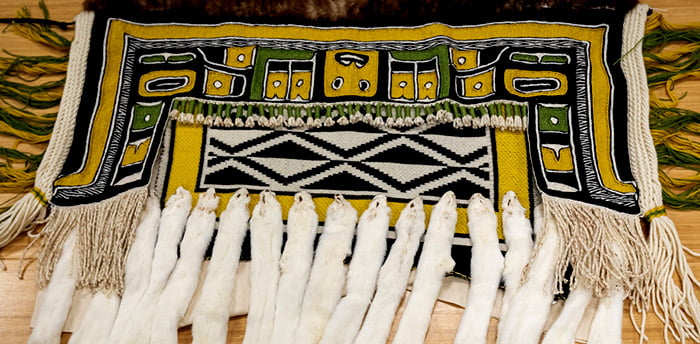
SHI ACQUIRES ROBE COMMEMORATING LEGAL STRUGGLE
Robe tells of historic effort to protect intellectual property rights
Jan. 30, 2024
Sealaska Heritage Institute (SHI) has acquired a Chilkat robe with a Ravenstail insert that documents the struggle to adhere to Tlingit law and protect Indigenous intellectual property rights.
The child’s robe, created by the noted weaver Shgendootan George, features Chilkat designs and a fragment from a former retail item that depicts a Ravenstail design.
A number of the retail items were destroyed in 2021 in accordance with Tlingit law and cultural protocol.
The acquisition is significant because the new robe demonstrates the continuation of Tlingit law and the incorporation of a fragment from a newer object that did not recognize Indigenous intellectual property rights.
“The sublime weaving surrounding the fragment by a master weaver memorializes the continued application of Tlingit law and the struggle for recognition of Indigenous intellectual property rights. It also highlights the skill and beauty of truly handwoven Chilkat weaving compared to a manufactured textile,” said SHI President Rosita Worl.
Historically, Tlingits were known to have incorporated pieces of a robe or other artworks into new pieces. Significant works of art were sometimes fragmented or cut up during a ceremony and distributed to guests as a way for the host to display power and wealth, but also to honor special guests. Those fragments would sometimes be incorporated into new art pieces or regalia as way to commemorate the gift and the clan that gave it.
The piece was acquired through a grant from the Museums Alaska Art Fund.
About the Weaver
Shgendootan Robyn Kay George was raised in Angoon, Alaska. She is the daughter of Gabriel and JoAnn George; her grandparents are Jimmy and Lydia George and Kelly and Olive Callahan, and her clan house is the Keet Oxoo Hít (Killer whale tooth house). Growing up in Angoon, George was surrounded by art and her culture. Her mother, who is an artist, knew other artists in the area, and they exposed George to weaving. Her teachers were Cheryl Samuel (who is credited with replicating the work of past Ravenstail designs and teaching other weavers) and Tlingit artist Clarissa Rizal. George learned how to do Chilkat weaving with Rizal and apprenticed with Samuel to weave Ravenstail designs. She credits the teacher-student apprenticeship with allowing her to feel a deeper connection to her weaving.
Shgen received her bachelor’s degree in fine arts from the University of Puget Sound and attended the Institute of American Indian Arts. She earned her teaching certificate from the University of Alaska Fairbanks and taught in Japan and Angoon before becoming a teacher at the Tlingit Culture, Language and Literacy program in Juneau. George’s work can be found at the Anchorage Museum, Stonington Gallery and other art institutions.
Sealaska Heritage Institute is a private nonprofit founded in 1980 to perpetuate and enhance Tlingit, Haida and Tsimshian cultures of Southeast Alaska. Its goal is to promote cultural diversity and cross-cultural understanding through public services and events. SHI also conducts social scientific and public policy research and advocacy that promotes Alaska Native arts, cultures, history and education statewide. The institute is governed by a Board of Trustees and guided by a Council of Traditional Scholars, a Native Artist Committee and a Southeast Regional Language Committee.
CONTACT: Kathy Dye, deputy director, Communications and Publications Department, 907.321.4636, kathy.dye@sealaska.com.